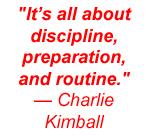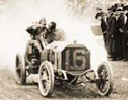Long Beach Driver Interviews
Long Beach, CA, April 19, 2009 — Julie Andre prowls the Long Beach pit lane and paddock looking for drivers to answer her questions on what the American Indy Lights drivers' goals are and their thoughts on the USF1. Then she asks a couple of ALMS drivers on the differences between road and street circuits and how they cope with multiple classes.
JULIE: What are your racing career goals?
 JR HILDEBRAND: My end goal is to be driving an IndyCar. Being an American, and growing up around the series, being able to come down to Long Beach, Sears Point, Laguna Seca over the years it's definitely what I aspire to do. I am in a position where hopefully I can make it happen in a couple of years. I think I may have a little bit of an advantage over the field not being a rookie and having some experience on ovals. I have been to a lot of the tracks before with a great team so I think we have a good shot at the title this year. One of the obstacles is the financial aspect of it. As a driver, you have to keep in mind that if the money is not there it is probably not going to happen. Hopefully, with the series gaining some strength and the economy turning around there will be opportunities in the future.
JR HILDEBRAND: My end goal is to be driving an IndyCar. Being an American, and growing up around the series, being able to come down to Long Beach, Sears Point, Laguna Seca over the years it's definitely what I aspire to do. I am in a position where hopefully I can make it happen in a couple of years. I think I may have a little bit of an advantage over the field not being a rookie and having some experience on ovals. I have been to a lot of the tracks before with a great team so I think we have a good shot at the title this year. One of the obstacles is the financial aspect of it. As a driver, you have to keep in mind that if the money is not there it is probably not going to happen. Hopefully, with the series gaining some strength and the economy turning around there will be opportunities in the future.
JONATHAN SUMMERTON: My goal is to make it to Formula One. You know the IRL is definitely a good step, but for me like I said it is definitely Formula One. It is the top level of motorsports, the pinnacle of racing. Of course, with the current economy it becomes increasingly harder each year to continue to move up to the next level especially with sponsors cutting our budgets.
DANIEL HERRINGTON: Indy Lights is definitely where my heart is now and where I want to be. It seems like the best stepping stone that there is. For now I am keeping my options open. The IRL seems pretty strong, and it keeps growing each year especially after the unification, so being in Indy Lights or the development series is the right place to be if an opportunity in the IRL opens up.
CHARLIE KIMBALL: Obviously, the plan here is to win here in Indy Lights. It's really a good stepping stone. It's also one of the only opportunities to learn how to go racing on an oval. It's the only place in the world outside of IndyCar where you can race on an oval in an IndyCar. So to me that's a big key as to why I am here. The other thing is it allows me to build my sponsorship package and hopefully try to introduce new partners to IndyCar. One of the things I am really excited about this weekend is I brought on a pharmaceutical company NorvoNordisk. I have been using their insulin since I was diagnosed with diabetes 18 months ago. I still take it, and it is nice to work with them and raise awareness and not only that, but I give them value now and introduce them to motorsports marketing. So then when I am ready as a driver to step up to IndyCar I can take them with me. It's really an exciting prospect! With the economy the way it is people are just being more careful and discerning making sure they are getting the value for each dollar they are putting in. That's one of the things that Indy Lights does a good job at, promoting young drivers, promoting American drivers, showcasing them and putting them in the same bracket as IndyCar as much as possible. For example, the autograph sessions, being on the same website homepage that sort of stuff. When we are ready to go to IndyCar we can take everything that we learned here. I am so excited about racing at Indy. It is one of the special race tracks in the world. I have had a chance to race at Monaco, the short circuit at Le Mans, but Indy is the big one that is missing still.
ANDREW PRENDEVILLE: The IRL is definitely my goal. IndyCar is where it is at.
JULIE: What are your thoughts on USF1?
HILDEBRAND: It's yet to be determined how it's really going to happen and how likely it is that it will start within the next year or so. I think it is really exciting news for open wheel racing in general. There is definitely a void in the United States in Formula 1 in North America particularly with the race in Canada being lost. There isn't much of a presence anymore. It's something we all look at as an opportunity moving forward. Hopefully some news will be coming out soon as to what direction it will take.
 SUMMERTON: I think it is a great thing to happen. It's really good for the country. I think it could be good for my career because I think they are looking for American drivers, so it's a lot easier for me to not have to go to Europe and fight my way through their system.
SUMMERTON: I think it is a great thing to happen. It's really good for the country. I think it could be good for my career because I think they are looking for American drivers, so it's a lot easier for me to not have to go to Europe and fight my way through their system.
HERRINGTON: It's pretty exciting! I really hope the guys can get it together and get out there. Being a fan of Formula 1 and an American race car driver it's been something I have been waiting to see for a long time. Maybe they will let me test drive one of their cars.
KIMBALL: I think it is great! I welcome any new racing opportunities that present themselves.
PRENDEVILLE: I don't think anything of it. They have talked about it for years and years with nothing happening. I have been in the sport for nine years now. I will believe it when I see it.
JULIE: What are the challenges racing with diabetes?
 KIMBALL: It takes a lot of discipline. I have a typical day regimen as far as taking my medication and on race days that changes because of the exercise, being in the race car, and the extreme temperatures, my body uses the blood sugar differently, and I like to have a safety margin. So, I adjust my doses of medication for meals and stuff. It's all about discipline, preparation, and routine. I have a couple of fail safes. I have drinks in the car for orange juice and other fluids with a high sugar content, so if I am getting low I can drink that.
KIMBALL: It takes a lot of discipline. I have a typical day regimen as far as taking my medication and on race days that changes because of the exercise, being in the race car, and the extreme temperatures, my body uses the blood sugar differently, and I like to have a safety margin. So, I adjust my doses of medication for meals and stuff. It's all about discipline, preparation, and routine. I have a couple of fail safes. I have drinks in the car for orange juice and other fluids with a high sugar content, so if I am getting low I can drink that.
JULIE: What are some of the differences in the ALMS cars between the road courses and street courses?
PATRICK LONG: The traditional street courses and road courses have different variables but both are very tough and demand a different thing. In the street courses you have lower grip surfaces so you need to run softer settings to get over the bumps and make the car grip. In the traditional road courses you have higher grip because it is a permanent race track. So you want to run a stiffer set up to make the tires last longer. With the stiffer lower settings you are working with the aerodynamics rather than the mechanical grip. There are a lot of different things that you have to work with your engineers with depending on the track.
ADRIAN FERNANDEZ: It's not too different. Obviously, you change the aero balance. For instance, the Miller track you would put less downforce, and here with the long straights you put a little less downforce than perhaps you do for St. Pete. So definitely there are changes but the platform of the car pretty much stays the same.
JULIE: What are some of the challenges with the mixed classes?
 LONG: The mixture of ALMS classes and the different speeds is a big challenge but it is a lot of what the action is about in this series and what the action is about in the endurance racing and the traditional sports cars where we have multiple classes. I have raced some sports cars where you don't have that. Three years ago, I was here with the Daytona prototypes and we only had prototypes, and I much rather prefer the mixed classes because you have a lot more elements of action. You have certain cars that allow you to get up the inside of your competition. Last year being here in a prototype I knew it was all about how you dealt with the GT car so it makes it more of a learning game. It is an equalizer. It turns out that it is not just a test of technology but of who is behind the wheel, and as long as it remains difficult to drive these cars I will have a job.
LONG: The mixture of ALMS classes and the different speeds is a big challenge but it is a lot of what the action is about in this series and what the action is about in the endurance racing and the traditional sports cars where we have multiple classes. I have raced some sports cars where you don't have that. Three years ago, I was here with the Daytona prototypes and we only had prototypes, and I much rather prefer the mixed classes because you have a lot more elements of action. You have certain cars that allow you to get up the inside of your competition. Last year being here in a prototype I knew it was all about how you dealt with the GT car so it makes it more of a learning game. It is an equalizer. It turns out that it is not just a test of technology but of who is behind the wheel, and as long as it remains difficult to drive these cars I will have a job.
FERNANDEZ: It is the toughest thing I think in this series just dealing with different classes at the same time. We have had contact with other cars that we are not competing with, and that's frustrating but there are differences in the braking and turning that you need to consider. This is our third year so I think we are getting more patient. When you are trying to keep the pace and are competing with others in your class, you obviously try, but if you get too stuck you may lose all of your advantage. It goes up and down.
JULIE: What are some of the differences between racing the ALMS cars and the IndyCars?
FERNANDEZ: Well, this car is very good. It's very good on the braking . It's not as fast on the straights, but it's very good on the breaking and turning. So in that respect it drives like an IndyCar. It just doesn't have the power. The ALMS car has other things shifting on the steering wheel and carbon brakes things like that which we didn't have in the IndyCars. But I think my experience in an IndyCar is helping me now.
Photos by
Copyright © 2009 by Julie Andre and Deep Throttle. All Rights Reserved.
| 



